Pirate metrics: how to create an email campaign based on the AARRR principle. Part 5
- Transfer

In the blog of Pechkin on Habré we write a lot about interesting techniques for working with email newsletters . Previously, we examined common mistakes when creating forms in mail letters, and today we present to your attention an adapted translation of the Sendwithus service team notes on which approaches to developing letters help to increase their conversion. The first part of the material can be read here , the second here , the third here , and the fourth here .
Money: Introduction
You did it! You are interested in the user, he makes repeated purchases with you and even became the “evangelist” of your product. Almost became. Perhaps his basket is full of goods or even abandoned, or maybe the period of free use of the product is coming to an end, but you are determined to overcome all the difficulties that marketers face.
This is the fifth and final chapter in which we will finally talk about money (dolla dolla billz yall). Our goal was to expand the funnel at all stages in order to bring more users to the last step. In this chapter, we will describe in more detail how to push users to purchase using the email newsletter, how to keep their interest after making a purchase, while they are still very enthusiastic.
Easy push: add new features and tackle abandoned baskets
You know what your users want to receive, and you know when they are ready to give up without ever getting what they want. Your user is just a step away from the purchase. You just need to find a way to push the user to purchase and automate this process. One solution to this problem (described earlier in this guide) is a letter about an abandoned basket.

Recently, the Baymard Institute conducted a meta-analysis of abandoned basket data from a huge number of suppliers. The average value was quite high - 65%, that is, only every third buyer completed the order. If you had kept the interest of half of the [abandoned carts] potential customers, your income would have doubled. But how to achieve this?
In order to truly understand how customers make purchasing decisions and how this process relates to sending emails, we decided to talk with some of our customers about reminder letters about abandoned baskets and what you can find out about your customers at those times when they decide: to buy or not to buy a product.
Automatically generated letters should not look like they were written by a robot
Our first interlocutor was Noah Taubman, a marketer, customer retention specialist via email newsletters at MeUndies (a brand of great lingerie and home wear). We talked about their abandoned baskets .
Since MeUndies developed their version of the letters about the abandoned basket, they have been testing every change in the contents of the letter to maximize its effectiveness. Noah says that he understood the most important thing - and this is not only knowledge of what topics [letters] people like (although this too). He said that the most important thing for them was the understanding that their users are smart customers, and, respecting their wishes, Noah was able to increase the general interest and unity with the brand.
To check this version, they began to work on the text of the letters, in an attempt to do something more than “another letter about an abandoned basket” - and as a result the style of letters became much less official. The bottom line is that knowing your target audience is invaluable to maximize the benefits of communicating with your user.
“The biggest response was given to campaigns that corresponded to our own unique style of communication, which we have developed over the past 2-3 years. In particular, we completely revised and altered all typical ineffective campaigns (for example, letters about abandoned baskets). ”
And this really echoes the content of the previous four chapters: each letter is an interaction with the client, an opportunity to understand why this person chose you first and why he is still devoted to your product. Even if you ignore these facts, your users understand all this, so at least respect their knowledge.
Guess the best
The next conversation we had with our friend Ally, who works in digital marketing at TeeSpring . They really have an interestingly organized email distribution (given that TeeSpring is a market place), because they must work with both buyers and suppliers. We asked questions specifically about customers.
There is another interesting thing in the TeeSpring strategy - they have time limits on the decision to purchase. After the campaign [mailing] begins, the final sale date is determined. Unfortunately, this does not mean that after this period the user who left the order unpaid will automatically be offered to extend the action.
“We achieved the greatest success when we assumed that the client wanted to buy a course from us and simply forgot. We reminded him in a letter that “product X is in stock,” and our conversion has increased significantly. ”
So the important tip is to track and test your assumptions, not just the exact wording. This kind of micro-testing can give interesting results, as in the aforementioned (real) letter about a forgotten product - these are trifles that can be easily forgotten.
These were the general advice of Ellie and Noah, and many other marketers that we have been interviewing over the past few years: the mailing list is what helps you test and improve your content, design, and even corporate ideology. Try to remember the big and small tips from this article and try to put into practice.
Do not offer a discount
Have you ever called a cable company trying to cancel your subscription, and as a result received the same services at a discount of $ 10 per month and six months of free connection to HBO? Then you left yourself a reminder to call again and refuse the free HBO, and everything repeated again? You don’t want to be like this company, do you?
Probably the first thing you do when working with abandoned baskets is to offer a discount because it seems like an easy way to regain customer interest. But there are several reasons why you should not do this:
First of all, there is a chance that the goods were refused not because of the price. According to Statista research, which presents the most common causes of failure, the price factor usually appears in only three of the ten leading causes.
Even if the motivation was price, according to Chad White, research director at Litmus: “When customers get incentive discounts, they get used to delay purchases and become more price-sensitive.”
However, providing a discount is not always a bad idea, especially if you are completely desperate, but consider other options (so as not to form a habit with the client). A great example of customer returns can be seen in the letter from Instacart:
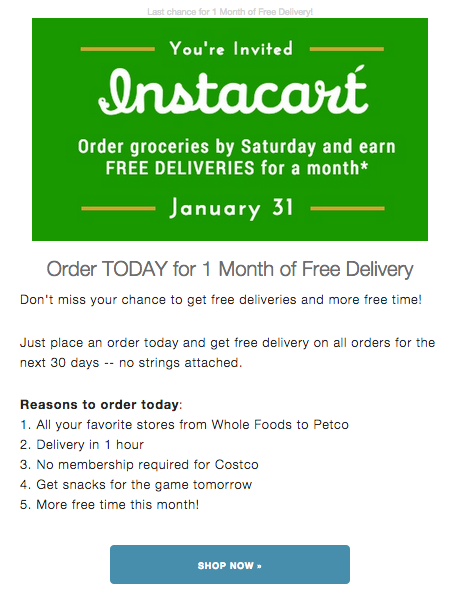
Free delivery from Instacart
This letter came two weeks after registering with Instacart, when I managed to go around the site, but did not place an order. I like that here other options are offered in addition to discounts: with the help of a letter Instacart tries to identify possible difficulties encountered by new users of the service. So you can get information about the sensitivity of the client to the cost of delivery, regardless of the duration of his life cycle.
Let letters be “personal”
On the topic of using your data: in a Listrak survey we checked just what intuitively seems reasonable: 71% of customers prefer to receive recommended products based on what they previously searched for; 80% - “for” recommendations based on purchase history. DonorsChoose, our adored customer, makes great use of this in practice. Letters from this company are created in the spirit of its value proposition, which states that everyone can make a better life near themselves - this is how this can be reflected in a letter with recommendations of projects that the user can support:

DonorsChoose tries to use non-standard techniques for design letters.
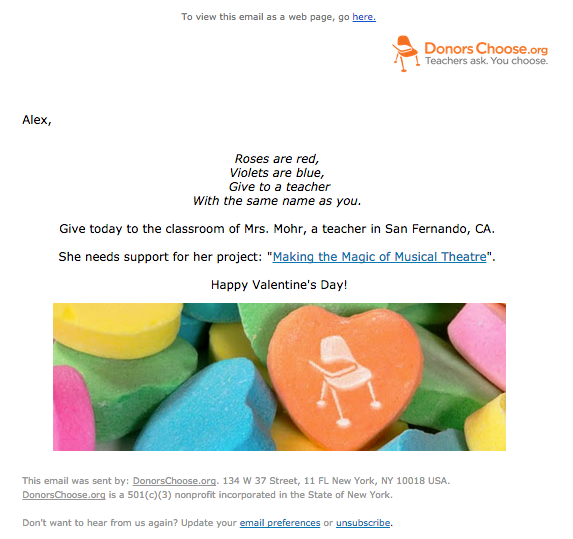
There is nothing better than a gift
Speaking of charity, never underestimate the ROI of gifts (an indicator of return on investment). This technique works equally well in both SaaS and ecommerce. And this is a great opportunity to remind you of purchases that your client has not yet had time to make or pay.
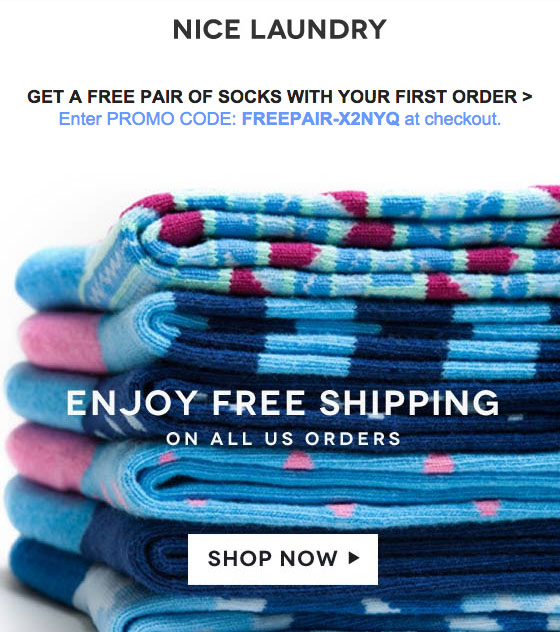
We like the examples of letters from different brands of clothes, because they [letters], as a rule, are designed better than others. Hey SaaS companies, join the game and work on your newsletter!
How to turn freemium into a paid subscription?
So far, we have mostly been giving more advice on retail and e-commerce topics. But what if you start the SaaS service? For SaaS companies this may be a new opportunity, but their most common problem is an attempt to convince the user to switch to the paid version after a free truncated functionality, or free, but limited in time of use.
Ask for user feedback
One way to get potential buyers is to ask them what they would like to see in your product. Since it’s cheaper to write a review than deciding to install a [paid] update, you’ll probably learn more about your customers [and move them forward in the sales funnel]. For startups in the early stages, this is also a great way to identify potential “evangelists.”
In an ideal world, you would have a complex system that allows you to automatically mark users who left the service after the trial period expires and send them an email asking them to test new features of the service that they previously lacked, or offer a discount in exchange for recommending to friends.

But even a little attention to the personality of the client will help improve the situation:

Watch the use of the product demos by your users
I love this tactic because it is cheap. You may need the help of engineers to prescribe the logic of the process - it will depend on the size of your company and the degree of automation, but this is a great opportunity to again “catch up” with missed opportunities.

Remind them that they are losing
In the examples above, this is well demonstrated, but you should always be sure that users are extremely clear what their next step will be. Does the user know what he is losing? Will he have access to his data?
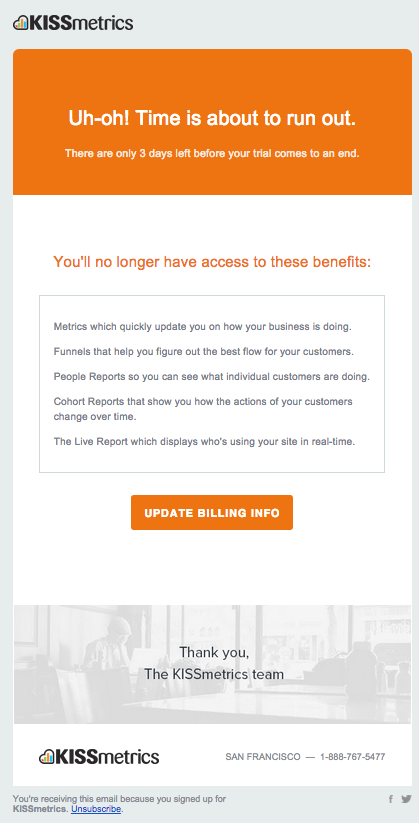
Sell your dream
At this stage, it is important to let the user know what benefit he will receive using the full version of your product. The easiest way is to send useful content (to attract the user's attention), and then convince the client that he needs the full version of the product in order to experience all its capabilities.
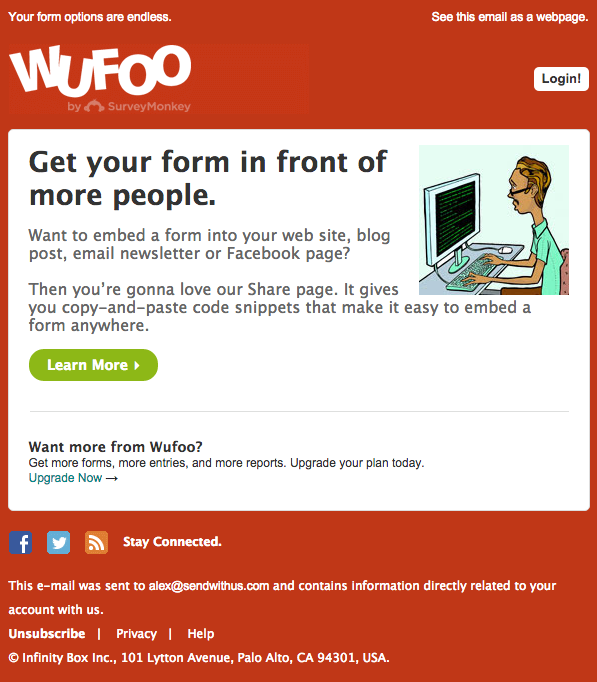
Account letters
Account letters are probably neglected more often than others, and this is a huge omission. By sending ugly decorated letter-invoices, you make it clear to the client that after paying the bill he is no longer interested in you. But this is exactly the moment when the customer is most involved in the buying process, so you must do everything possible to make money on it. If you do not know what the ugly execution of letters of accounts can lead to, then you are lucky - we have compiled a list of six tips to help you.
1) The letter must be beautiful
This was often mentioned in each chapter, but at the income generating stage it is still important: your transactional letters should be executed in the same style as your website and marketing communications.
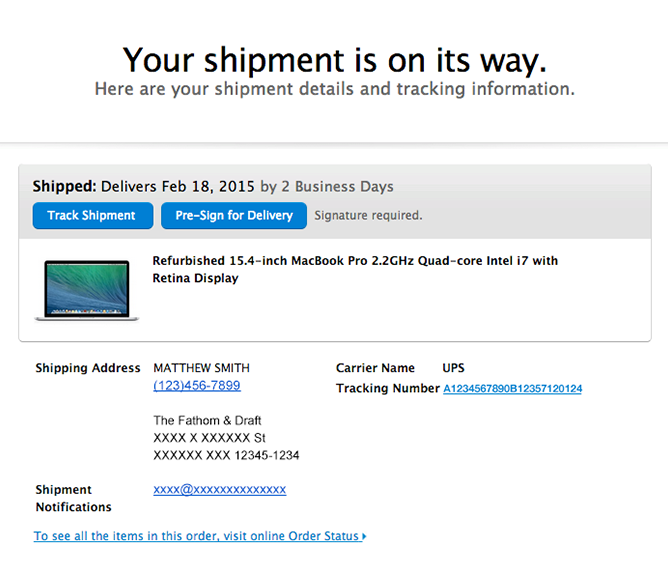
2) Work on the content of the letter, do not attach attachments to it
Please do not send your receipts as an attached PDF (except in rare cases when a client has concluded a major transaction). Nobody likes that.
The reason email is still the most valuable marketing channel is personal communication. If for one reason or another you have to force the user to leave the mail application, let him go to your site (and not mess with the files attached to the letter).
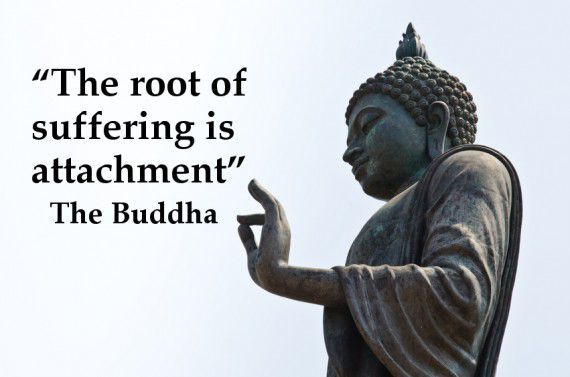
Attached files are a source of suffering
3) Use a valid sender address
Consider the following situation: sometimes you need to write an answer to a letter with an invoice: for example, you accidentally ordered something unnecessary or, conversely, missed something, entered a mailing or billing address with an error, made an inaccuracy when entering payment information. There are other reasons, and they are all very urgent. Therefore, make sure that your customers have a direct opportunity to resolve the problem as quickly and easily as possible.

What if I wanted to answer? This action is very important. The user himself wants to contact you directly, to establish a connection with you. After you have so hard instilled in them a desire to interact with you, why don't you give them the opportunity to contact and ask them not to reply to this letter?
In many ways, this seriously damages the strategy of “pirate metrics”. It is built around things that a startup team needs to do on their own, because they are difficult to scale. Scaling will require attracting new resources to create opportunities for customers, but having learned how to correctly calculate the return on these investments, we begin to understand that they are paying off with interest.
4) Offer a rebate discount
Unlike the situation with an abandoned basket, a re-order is the behavior for which you want to reward a customer, especially if your business depends on re-sales. This can be seen in the example of Redbox.

5) Ask the client to write a review
If you give the customer the opportunity to immediately leave a review, you will find out about possible problems that may arise in your sales experience. A great option is to install simple “Like” and “Dislike” buttons, which do not require unnecessary actions from the user - so you can evaluate the mood of people after completing the order.
If your product is a physical product, then you can kill two birds with one stone by asking to evaluate both the quality of the goods and the quality of delivery. It will also work great if you sell your product on the marketplace, or if you already have a built-in feedback system that can visualize these ratings.

6) Plan re-purchase options
This is not a quick process. In many cases, this is an opportunity to once again remind yourself. Sometimes this is an attempt to take advantage of past achievements and send another offer to the client in the wake of previous success. Regardless of what motivates you, maintaining a subsequent (after sale) relationship with a customer is always helpful.
Good customer relationships can also come in handy when selling seasonal products. Including worst season: tax season.

Conclusion
This concludes the fifth and final chapter of our guide. And again you need to be warned: do not try to implement all these tips at once. Maybe you should just bookmark this page and come back to it when you encounter difficulties, and you need an idea, or maybe you plan to test one piece of any advice from this article once a couple of weeks. The most important thing for you is a constant desire to become better.
